|
Esta página no está disponible en español.
Designer Monthly Magazine
Sheffield School Of Interior Design
Armchair Decorating
by Pettie Cash
MAY, 2002
Copyright © 2002 Designer Monthly Magazine. All Rights Reserved.
"Reprinted with permission from the Sheffield School of Design web site at
http://www.sheffield.edu
[PHOTOS: Charles Delaney ©Copyright 2002, Geraldine de Haugoubart ©Copyright 2002]
Just as I was getting used to the comforts of civilization, the Powers That Be at Sheffield reminded me that this Armchair Decorator column is a regular monthly gig, so I packed up my Lancome travel bag yet again and boarded another plane, this one bound for the slightly more advanced island of Puerto Rico.
First of all, I wanted to know just what is this thing called Puerto Rico? I mean, it's American, but the official language is Spanish and they've got their own flag. You don't need a passport to get there; in fact, if you flash your passport in its attractive little Coach leather passport holder, and you happened to have just dyed your hair shockingly from brunette to blonde, nobody even looks up.
It turns out that Puerto Rico is a little prize that America won from Spain in the Spanish-American War. In 1917, all Puerto Ricans were granted U.S. citizenship, and it was only a short hop from that to the opening of the first KMart, and from there it was just a blink to the opening of the first Gap store.
But this information doesn't clear everything up, either, and the situation of Puerto Ricans seems a bit iffy when you consider the trade-offs. Puerto Rican residents do not pay federal income tax but they do pay social security; they don't get to vote in presidential elections but they do serve in the armed forces. I was still trying to figure all this out as I settled in for that initial pina colada on the deck of the restaurant looking out over the Caribbean sea.
But you sure know in Puerto Rico that you've left the stateside shores. For one thing, there's plenty of wilderness for people who like that kind of thing; just thirty-five miles from San Juan, there's the El Yunque rain forest, with its wild orchids, squeaking tree frogs, and colorful parrots. If you're inclined toward hiking, you can trek various trails through the forest, just hoping to encounter some wildlife and to experience some of that dripping water.
And there are other outdoor activities. If for some reason the idea of sealing yourself into a wet suit and hefting an oxygen tank onto your shoulders in order to sink into the depths of the ocean appeals to you, there is, reportedly, terrific diving available. You can join a group on a boat leaving from Rincon to get out to Desecheo Reef, where you can see all kinds of scary things that lurk in the waters. Or you could just snap on a snorkel and mask and float on the surface, and still have a chance to see some great fish.
Or so I'm told.
Of course, my idea of adventure vacationing is more along the lines of slipping into the swimming pool while I can just hear the waves crash on the shore nearby. Happily, Puerto Rico is so civilized that this isn't difficult to achieve, and there are plenty of resorts dotting the coast where you don't have to dodge sharks or waves, and the only boas you're in danger of seeing are made of feathers and are draped around the neck of some Latina chanteuse.
And Puerto Rico isn't just a place for a quick winter getaway, although it certainly is that. The temperature stays about the same year round, hovering at a nice eighty degrees, although the humidity does get heavy in July and August. Still, as long as you can pop into the pool or the air-conditioned hotel room, it remains a glittering green jewel throughout the seasons. And there are lots of nice-looking hotels.
The roads that traverse the island are for the most part in great shape; on the major highways, you could think you're driving around in California. You can travel the entire perimeter of the island not only on good roads, but on good roads with frequent shopping malls and modern, American-looking eateries.
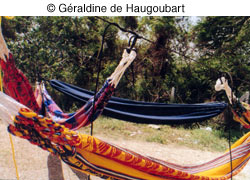 But I tried to remember my purpose here, which was to bring back the native goods. I stopped for a refreshing "coco frio," a chilled coconut with a hole dashed in the top and a straw stuck in, but that didn't seem the kind of thing to bring back for Sheffield. But I tried to remember my purpose here, which was to bring back the native goods. I stopped for a refreshing "coco frio," a chilled coconut with a hole dashed in the top and a straw stuck in, but that didn't seem the kind of thing to bring back for Sheffield.
But then, just as the sun slipped toward the horizon, I came across a roadside stand where a native woman and her children were selling hand-made hammocks, some of them woven and some of them made of rope. I got out of the car and in my broken Spanish asked, "Cuanto questo?" tossing in, for effect, "muy bonita." Even I was impressed with my near-fluency.
The woman pushed a strand of dark hair from her dark eyes, and said, "They're twenty dollars each," in a perfect Brooklyn accent.
But never mind that. The hammocks were perfect, each one with different colors, some with a pattern of fish, some with simple ribbons of red or blue. Some of the hammocks — the ones that were only ten dollars — were nothing more than a length of material cut to size and stitched on either end to hold the rope that then attaches to palm tree or Park Avenue terrace.
The hammocks would be great for a deck overlooking a back yard or a lake or a sandy beach. There was enough variety that a person could find one to fit any color scheme or mood.
I did feel it incumbent upon me to try one out, so when got back to the beach I tied the ends of the hammock firmly to the tree that sat just at the surf's edge, slipped off my Manolo Blahnik sandals and climbed in.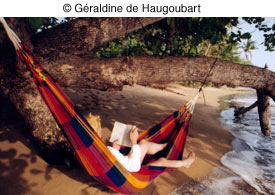
Maybe I could get used to this Armchair Decorator thing, after all. Is it too early to ask The Powers That Be for a vacation??
Not That You Asked
Puerto Rico
What I'd like to know is why do some people have a finely-honed sense of design, an aesthetic sensibility that I find lovely and charming, and others have a design sense that leaves me feeling like a big rock is sitting on my chest? And why are those in the latter group allowed to build and design public places and private hotels and restaurants?
I don't think this has to do with money. Often, when I point out a terrible-looking house or something, someone will say, "It's cheaper to do it that way," but this isn't always true.
Witness the island of Puerto Rico. There's a pretty big gulf there between the haves and the have nots, and the haves are, for the most part, living in big, ugly houses, houses that have nothing to do with the natural landscape but which try to approximate the look of big, ugly houses in the northeastern United States, complete with neatly-mowed lawns of grass. For those readers who are not horticulturally-minded, I'll just point out that grass is not a native plant in a place where there's a mean temperature of 80 degrees year round.
And then there are the houses of the have-nots, which, at least in Rincon, the town I visited, are little and sweet, with their tiled patios framed by wrought-iron doors painted white. While I'm sure the residents there would love to have more room in their homes, many of them have made the most of what they do have, and what they have often includes a terrific wide view of the ocean.
There are plenty of pastel colors here, which provide a nice counterpoint to the bright, dark green of the hillsides and the deep blue of the sea. These smaller houses fit in with the landscape quite literally, hanging on to the hillsides like snails on a rock, clinging on the steep cliffs for dear life.
Of course, while in Puerto Rico I had to stay somewhere. At first, my Internet search led me only to the big, ugly hotels lined up on a beach in San Juan, making the rooms about as far from the beach vertically as you can get. I could imagine their hallways, fluorescently-lit. I could imagine the rooms with their conditioned air, with windows that don't open and even if they did, the sea's sounds would be invisible from way up there in the tower.
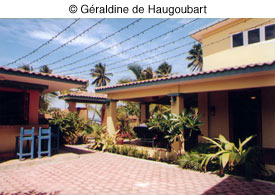 It took some doing, but after more searching, I found what I was looking for, and this inspired in me hope once again, hope that we aren't all tumbling toward making the world into one big laminated ball. What I found was a small hotel in Rincon called Casa Islena, with just seven rooms, and designed like a Mexican hacienda by the owners, Dario and Wendi Respeto, who live just down the street and breakfast at the hotel every morning with their two sons. They even went to Mexico themselves to get the terra-cotta floor tiles and the heavy wooden furniture, not to mention to take careful note of what makes something look "Mexican." It took some doing, but after more searching, I found what I was looking for, and this inspired in me hope once again, hope that we aren't all tumbling toward making the world into one big laminated ball. What I found was a small hotel in Rincon called Casa Islena, with just seven rooms, and designed like a Mexican hacienda by the owners, Dario and Wendi Respeto, who live just down the street and breakfast at the hotel every morning with their two sons. They even went to Mexico themselves to get the terra-cotta floor tiles and the heavy wooden furniture, not to mention to take careful note of what makes something look "Mexican."
The Mexican look is a combination of a Spanish look, which itself brings in Moorish and Middle Eastern influences, and the local look of the native Mexican Indians. It's a blend, and it's one which works not only with the Mexican landscape, but with any landscape that's hot and dry. Throw in a nearby ocean and you're set.
This look relies on a climate in which you don't need much protection from snow — or even from rain, for that matter. The roofs in Rincon are notably flat; these people don't have to worry about pitching their roofs so that snow will run off. At Casa Islena, the dining area is an open-air porch, covered by a roof to provide some shade, and the rest of the place is just as open, so that you don't really feel that you're inside until you shut the door to your room. The biggest problem with the elements is cleaning the sea spray off the windows that face the water.
The colors are also an important consideration in trying for a Mexican look: bright yellows and blues predominate, and these reflect the blues and yellows of the sea and the sunlight.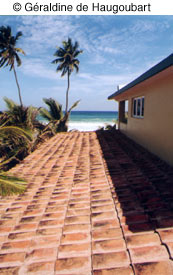
Now, I have hope again in part because Casa Islena is a very new hotel, built just last year — it isn't that it's old and everyone else is moving forward into the brave new world of high rises. And — ah ha! It's no more expensive to stay there than it is to stay in one of the big towering hulks.
Of course, not everyone in Rincon has the same good sense as the Respetos. Down the beach in either direction there is a restaurant, both on the beach, both, predictably, serving seafood and pina coladas. But one restaurant has a big parking lot out front and a huge indoor dining room that looks as native to Puerto Rica as a Red Lobster in Piscataway. Laminated wooden tables, parents shushing their screaming kids, waiters in Hawaiian-print shirts, the whole thing. Surf and turf on the menu.
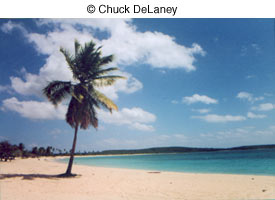 On the hotel's other side, there sits Beside the Pointe, a little surfer shack, with an open porch right on the beach, and an indoor area that's little more than a slab of concrete with a thatched roof over it. Here, the speciality is fish nuggets, and if you go there two nights in a row and make friends with the cook, he'll prepare just about any dish you want. Here, the owner is the waitress is the bartender, and you can sit as long as you like, your bare feet propped up on the railing, drinking your pina colada out of your plastic cup, waiting with the owner/waitress/bartender's father for the annual return of the sea turtles who by full moon lumber from the water to lay their eggs in the sand. On the hotel's other side, there sits Beside the Pointe, a little surfer shack, with an open porch right on the beach, and an indoor area that's little more than a slab of concrete with a thatched roof over it. Here, the speciality is fish nuggets, and if you go there two nights in a row and make friends with the cook, he'll prepare just about any dish you want. Here, the owner is the waitress is the bartender, and you can sit as long as you like, your bare feet propped up on the railing, drinking your pina colada out of your plastic cup, waiting with the owner/waitress/bartender's father for the annual return of the sea turtles who by full moon lumber from the water to lay their eggs in the sand.
This, to me, is living. This is a perfect design. Sure, I like my comforts as much as the next spoiled American. I like a little air-conditioning, a good bed to sleep in, a clean bathroom. But what I can't understand is this drive to make all the world look like a Howard Johnson's. Not when you can feel the smooth Mexican tile under your feet as you cross the patio to your room, where the open windows let in only the sound of the sea.
—Sarah Van Arsdale
| 
